Industry Canada Acts on TV White Space
Here is part of the decision:
It is unclear if Industry Canada has decided to use the same obsolescent R-6602 propagation model that FCC used and that overprotects TV reception or is using a mode accurate model or has just deferred the issue for further consideration. More later.The management of the radio frequency spectrum has traditionally been a centralized process, with the access to spectrum overseen by a regulatory body. However, as technology has progressed, methods allowing dynamic spectrum access have begun to be developed to improve spectrum efficiency. A shift away from conventional licensing approaches could lead to a more flexible, adaptive administrative environment by enabling opportunistic use of the radio frequency spectrum. Such techniques for the use of TVWS have the potential to improve spectrum efficiency while facilitating the introduction of new wireless communications applications in Canada.
Some respondents express some apprehension about the introduction of TVWS devices due to the potential for rapid proliferation, especially in the context of licence-exempt operation among licensed systems. On the other hand, appropriate technical requirements and the ability of these devices to adapt their operation in real time should ensure that incumbent users do not suffer harmful interference. Industry Canada believes that the regulatory approach described in this document will provide the necessary measures to address these concerns.
Industry Canada will also closely monitor international regulatory developments, and will make appropriate regulatory changes as further experience is gained. It is noted that TVWS rules in the United States have been finalized and remaining legal obstacles to related TVWS deployment have been resolved. The development of rules and regulations for TVWS use are also moving quickly in many other countries, including in the United Kingdom, where rules development is particularly advanced.
Despite the potential that repurposing of some TV spectrum below 698 MHz in the United States might lead to calls for similar action in Canada, Industry Canada does not see this as a reason to delay the introduction of TVWS devices. If Canada were to follow the United States, available spectrum would be reduced and fewer geographical areas would be available for the operation of TVWS devices. However, proponents have indicated their belief in the ongoing viability of TVWS use regardless of whether such changes take place.
It is expected that the introduction of the use of TVWS devices will enable the development of new techniques for managing the radio frequency spectrum while easing spectrum shortages and enabling more options for wireless broadband and Internet services for consumers.
Looking Back to Look Forward: The Next Ten Years of Spectrum Policy
Looking Back to Look Forward: The Next Ten Years of Spectrum Policy
Tuesday, November 13, 2012; 1:00 - 6:00 PM
@ Pew Research Center, Washington, DC
Co-Sponsored by Silicon Flatirons Center - A Center for Law, Technology, and Entrepreneurship at the University of Colorado, CTIA - The Wireless Association and Public Knowledge
In Cooperation With the Federal Communications Bar Association and IEEE-USA
The regulatory foxtrot - slow, slow, quick, quick, slow - means that participants in the spectrum policy dance need to keep an eye both their current and future partners. Multiple cycles line up this year: it's a century since the sinking of the Titanic and the 1912 Radio Act, ten years since the FCC Spectrum Policy Task Force Report (SPTFR), and the end of a four-year Administration that saw the FCC's National Broadband Plan, a Presidential Memorandum calling for 500 MHz of spectrum to be found for wireless broadband use, and a report of the President's Council of Advisors on Science and Technology (PCAST) about realizing the full potential of government-held spectrum.
It is a time when pressure on spectrum allocations keeps growing due to the drumbeat of new broadband wireless applications, a crowded dance floor with a growing diversity and density of conflicting radio operations, and a crescendo of technologies such as smarter radios and heterogeneous networks. This presents an opportunity to look back at lessons learned, and prepare for challenges of the next four and ten, if not a hundred, years.
Panel 1: The Promise and Problems of Strategic Plans: From the Spectrum Policy Task Force to the PCAST Report
A decade ago, an intensive multi-disciplinary review culminated in ground-breaking staff report that is still often quoted. Recent years have seen similarly ambitious strategic plans from the FCC and the White House: the National Broadband Plan, the President's Memo, and the PCAST report. What lessons can be learned about strategic spectrum planning from the impact and unfinished business of the SPTFR? How should these lessons be applied to the current crop of recommendations?
Panel 2: Reforming US Spectrum Management: Sharing, Reallocation and Other Options
The FCC's National Broadband Plan and the President's spectrum initiative laid out aggressive goals for spectrum reallocation to commercial mobile broadband, and the PCAST report recommended sweeping, long-term reforms of government spectrum management. Sharing has become a serious option. What are the strengths and weaknesses of these proposals; what needs to be added or taken away? What are the prospects for improving the transition from old to new ways of using spectrum for federal and non-federal users.
Panel 3: The View Ahead: Technology opportunities
Regulatory discussions are informed by technology trends, and wireless research continues to open up new policy possibilities. What are the long-term technology trends and constraints that will drive spectrum policy over the next ten years? This panel will lay out what to expect, and when, as we move to ever-denser packing of bands.
[Your blogger is speaking on Panel 1]
Spectrum Policy for National Government Users: A Worldwide Policy Challenge

National governments around the world are generally large scale spectrum users for their military and civil governmental operations. Today, many governmental functions are spectrum intensive due to the increasing mobility and use of information in today’s societies and economies. The civil functions range from air traffic control to public safety operations to fixed and mobile wireless networks to support other functions that are key to toady’s societies. The spectrum resources that are used for such governmental functions are generally not available for private sector users, although some sharing is possible in classic spectrum policy. National government spectrum use is a difficult regulatory issue because the very same national government that is using such spectrum includes the regulator that sets the rules for private sector use. In many countries military authorities play a key role in national spectrum management.
Spectrum is generally fungible for national government and private sector use and is a key input to wireless systems that have a large impact on national economic growth which in turn impact national government revenues. This article will explore the policy challenge of regulation national government spectrum use and discuss a recent US report on the issue.
Different countries have chosen different mechanisms for balancing national government and private sector spectrum use. In Japan, the Ministry of Internal Affairs and Communications (MIC) is the unitary regulator of all spectrum use and consistent with the Japanese style of government deals with other agencies on a somewhat distant basis. In the US, spectrum policy responsibility is split between the independent Federal Communications Commission (FCC) with jurisdiction over private sector and local government use and the executive branch’s National Telecommunications and Information Administration (NTIA) with jurisdiction over national government use. In the United Kingdom the Office of Communications (Ofcom) has responsibility for the “communications sector” while the national government, acting through a little known official committee of the Cabinet Office, the UK Spectrum Strategy Committee (UKSSC), has responsibility for national security and public safety spectrum use.
In the UK, the government has stated that “public bodies will acquire spectrum through the market, with administrative assignment by Ofcom only being made in exceptional cases” and that “(t)he Government is committed to paying administered incentive pricing (AIP) on its spectrum holdings”. (AIP is an estimate of spectrum value based on spectrum scarcity and other factors. ) In the US and some other countries, national government spectrum users pay a small fee for spectrum use that is calculated only on NTIA’s administrative costs and is independent of free market spectrum value. Thus the UK is unique in the world for its progress in treating spectrum use by the national government basically on the same economic terms as private sector use. While this may seem unusual to people who have dealt with spectrum for a long time, national governments around the world generally pay market prices from other key resources and products they use ranging from electricity to fuel to vehicles to land.
In July 2012 the US President’s Council of Advisors on Science and Technology (PCAST) released a report on national government spectrum use policy entitled “Report to the President: Realizing the Full Potential of Government-held Spectrum to Spur Economic Growth” . Parts of this report has been very controversial within the US because it advocates limiting previously planned reallocations of national government spectrum to commercially-operated mobile broadband systems and focusing on accommodating commercial spectrum use on increased sharing of spatial and temporal bands by national government users and private sector users. But in addition to this controversial recommendation there are several other recommendations that have received little attention and may be applicable to situations in other countries.
The report finds that “(t)here is no incentive system today for Federal (national) Government agencies to be efficient in their use of spectrum or to share spectrum allocated to them with the non-Federal (private/local government) sector” and recommends that the “essential element of this new Federal spectrum architecture is that the norm for spectrum use should be sharing, not exclusivity.” Because much national spectrum use is different in temporal and geographic characteristics than much of the other use, it finds that sharing will be possible in many cases with the provision that non-national government users must change their spectrum use temporarily when and where there is a surge of national spectrum use, for example during military training exercises.
The report recommends that national government agencies using spectrum should be given incentives to decrease their spectrum use because increased spectrum availability for the private sector has real economic benefit. Generally government entities are subject to strict budget constraints that make it difficult to impossible to explore system design changes to existing systems that could lower their spectrum requirements. While US already now provides for agencies to be reimbursed for the cost of moving to new bands, the cash flow of agency expenditures to plan and implement such a change and the reimbursement to the agency do not match well in terms of timing and amounts.
The report suggests creating a revolving Spectrum Efficiency Fund that “recycles private sector payments for use of Federal spectrum into reimbursements to Federal agencies for investments that facilitate spectrum sharing and enhance spectrum efficiency. Congress should allow the Fund to reimburse qualifying costs by any Federal service, not just those in revenuegenerating bands.”
The new fund would not have the cash flow limitations of the present scheme that discourage agency investments in planning studies and small scale tests of new technology since they can not be reimbursed presently until the spectrum has been auctioned to private users – possibly years later. The report goes further in recommending a major accounting change to facilitate agency changes that make more spectrum available to others:
“Spectrum currency is our name for a synthetic currency that would give agencies a means to identify the opportunity costs associated with their use of spectrum and to obtain benefits by sharing or vacating some parts of their assigned spectrum and provide a way for them to “buy” their spectrum usage rights and reduce their spending by improving spectrum efficiency…To turn their gains in efficiency to practical advantage, agencies desiring to accelerate their transition to the new scheme could use their spectrum currency to bid every year for equipment credit from the Spectrum Efficiency Fund … that would enable them to increase their service quality.”
The UK has led the way in holding national government spectrum users more accountable for their spectrum use through the pricing of spectrum for most government and private spectrum users. The recent US PCAST report explores new options to try to balance the equities of national government and private sector spectrum use. These will generally be controversial in each country and it is important that the technical wireless community become familiar with the issues involved in order to contribute to national deliberations on what is the best approach for each country.
FOIA Practice @ FCC: Is FCC Consistently Over-redacting?
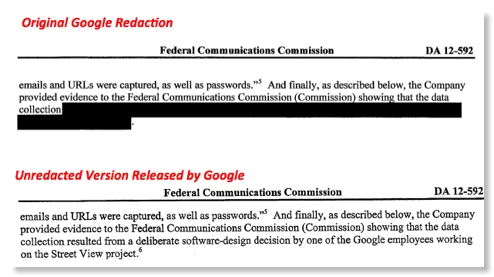
Here we see that FCC initially accommodated Google’s request to redact a phrase because it was “proprietary”, but the unredacted text later released by Google when public pressure was too great shows that what was involved was not proprietary information covered by FOIA Exemption 4, rather it was just wrongdoing that was embarrassing to Google.
Recently, FCC finally issued an Order on your blogger’s appeal of Motorola’s redaction of a letter they sent FCC in response to questions about interference to safety-related weather radars that was caused by Motorola equipment. (Motorola has since sold the division involved.)
Original Motorola Redaction Initially Upheld by FCC Staff
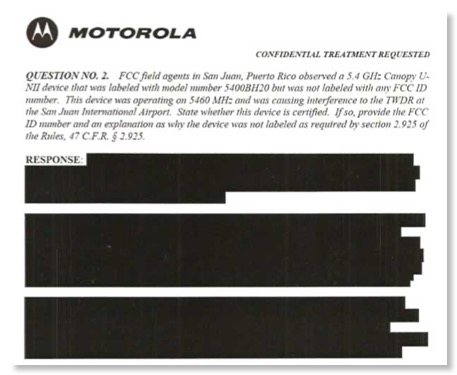
Redaction After FCC 9/12 Order
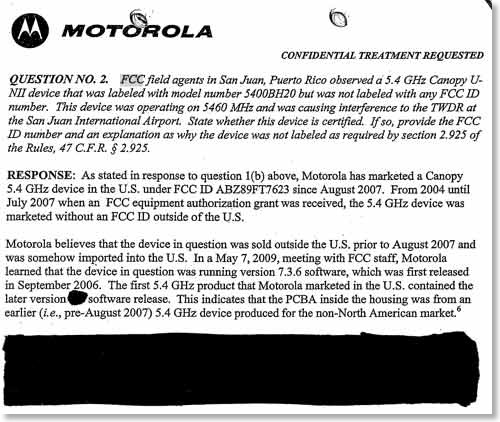
Motorola insisted throughout this struggle that the whole response to the above Question 2 was subject to FOIA Exemption 4. As in the Google case, readers might want to contemplate if Motorola had any rational justification to say that the 2 paragraphs now (mostly) unredacted was really "trade secrets and commercial or financial information obtained from a person [that is] privileged or confidential" or was it just embarrassing?
The new FCC Order stated that two sections of the Motorola letter in question remain completely redacted. In view of the information revealed in the above lesser redaction, one wonders if those redactions are really proper. Is FCC just too ready to accept corporate request for redactions without making real public interest determinations?
Your blogger intends to appeal the 9/12 Order and would welcome any pro bono legal help in such an appeal.
FCC FOIA processing has had some criticism from the right wing recently. The Daily Caller recently had an article entitled “FCC FOIA denial rates higher than CIA for ‘records not reasonably described’” based on numbers recently revealed by Florida House Republican Mario Diaz-Balart. Raw data is available at 2011 FCC FOIA report.
reason.com alleges
“What's the quickest way to get a FOIA request returned by the FCC? Try asking it for information about a political enemy of the Obama administration.”
In less than a month Citizens for Responsibility and Ethics in Washington — a group funded in part through the philanthropy of left-wing billionaire investor George Soros — obtained 233 pages of records on Rupert Murdoch and his News Corp. media empire, from between Jan. 1, 2006 and July 15, 2011, according to documents available on CREW’s Scribd account.
It appears that FCC is more protective about Google and Motorola than Rupert Murdoch.
UPDATE
Our friends at CommLawBlog now have a post on this issue entitled “FOIA Request Turns Up Info on Non-FCC-Compliant Transmitters”. Here are some quotes:
Because the transmitter operated outside its FCC-certified frequency range (among other problems), the FCC determined it did not qualify for unlicensed operation, and so fined AT&T for not having a license – even though AT&T could not have obtained a license for that service. Our friend Michael Marcus, a spectrum-savvy engineer (and former FCC official), asked a different question: how did the transmitter get to be operating on a non-certified frequency? Where most of us would be content to mull this over in our idle hours (if it occurred to us at all), Marcus is made of different stuff. He not only took the question to the highest reaches of the FCC, but managed to get some answers….
The mystery continues, as does occasional interference to airport radars. Users of the Canopy transmitters have no easy way to check the operating frequency or the presence of DFS capability. But those within the U.S. can – and should – look for an FCC ID number on the unit. If the number is missing, the user is on notice that the device is not only unlawful, but also a potential threat to air safety. For the sake of all air travelers, please turn it off
In Memoriam: Steve Jobs
Today is the anniversary of Steve Job’s passing.
In memory of this great man I am posting the video of his Stanford commencement address which I strongly recommend.
Memorial video from Apple website.
10 great quotes from Steve Jobs (CNN)
FCBA Brown Bag Lunch on PCAST Report and Its Impact on Federal Spectrum Policy

Speakers: Preston Marshall, Deputy Director, Information Sciences Institute, University of Southern California and "Invited Expert" contributor to report; Larry Irving, Irving Group (Former NTIA Administrator); Christopher Guttman-McCabe Vice President, Regulatory Affairs, CTIA
This discussion will be different than previous ones int eh DC area in that the speakers have been asked not to focus explosively on the issue of sharing vs. reallocation, rather they will also discuss other key issues int he report such as receiver standards and reform of federal spectrum management. It is you blogger’s viewpoint that no substantive progress in repurposing federal spectrum through either reallocation (favored by the cellular industry) or sharing (proposed in the PCAST report) is possible without some fundamental changes in federal spectrum management.
Reservations are needed. Go here to register. (Note FCBA members are required to login, nonmembers are required to set up a guest account.)
Location: Hogan Lovells US LLP, 555 Thirteenth Street, NW (Fulbright-East conference room). Check in at the concierge desk located in the building's lobby.
Hope to see you there!
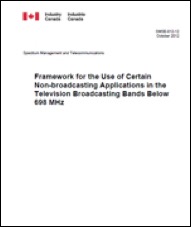


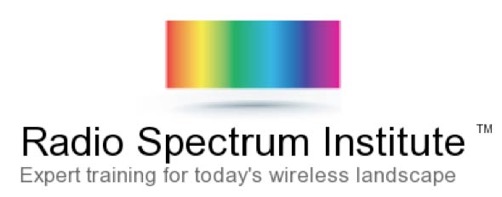


![Validate my RSS feed [Valid RSS]](valid-rss-rogers.png)

